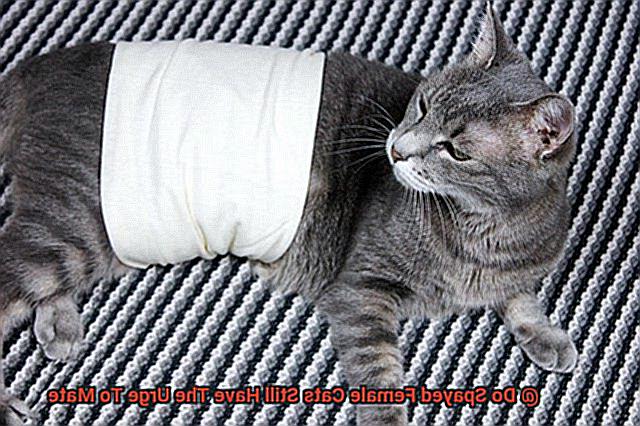Do spayed female cats still have the urge to mate? It’s a common question for pet owners.
The answer is yes, spaying your female cat does reduce the chance of pregnancy, but it doesn’t completely eliminate her urge to mate.
In this blog post, we’ll explore why this behaviour occurs and what can be done to prevent it. We’ll also discuss how to tell when your cat is mating and how to minimize her stress levels so she won’t have to mate as much.
Let’s dive in and find out all you need to know about do spayed female cats. You will take steps to ensure your cat is healthy and happy by understanding why your cat behaves in this manner.
Behavioral Changes after Spaying
Spaying your female cat is an important part of responsible pet ownership, and it comes with a range of health benefits. Not only does it help reduce the number of unwanted litters of kittens, but it can also have a significant impact on your cat’s behavior.
When a female cat is spayed, her ovaries and uterus are removed, which eliminates her ability to reproduce. This leads to a decrease in the levels of estrogen in their body, resulting in less sexual behavior. This means that spayed female cats are less likely to engage in mating habits such as yowling, hungering, and rolling on the ground.
Spaying can also lead to changes in a cat’s personality or behavior beyond just reducing sexual activity. Many cats become more laid-back and affectionate after their surgery, as they are no longer preoccupied by the desire to mate. However, some cats may experience behavioral changes that owners find concerning, such as increased aggression or anxiety.

Although spaying will help reduce female cat sexual activity, it will not completely eliminate it. In some cases, a spayed female cat may have a condition called phantom pregnancy where she exhibits signs of pregnancy despite not being pregnant. Additionally, male cats may still try to mate with spayed females due to residual pheromones.
Phantom Pregnancy
Your cat may be suffering from phantom pregnancy syndrome.
Phantom pregnancy is a common problem among spayed female cats, and it occurs when the cat’s body believes it is pregnant even though there are no visible fetus present. This is usually attributed to a sudden decrease in reproductive hormones after spaying. The cat may display signs similar to those of real pregnancy, such as nesting behavior, aggression, and yowling.
Although the condition usually resolves on its own within a few weeks, it is still important to provide your cat with a peaceful and calm atmosphere during this time. Additionally, increased attention and playtime will help her avoid the false pregnancy symptoms. In rare cases, if the cat’s behavior becomes severe, medication may be necessary to relieve the symptoms.

It’s important to remember that phantom pregnancy is not an actual pregnancy and that spayed female cats cannot become pregnant.
Interaction with Male Cats
Interactions between spayed female cats and male cats can be complex and require careful monitoring. Spaying a female cat typically reduces or eliminates their sex drive, making them less likely to engage in mating behaviors.
However, male cats may still attempt to mate with spayed females, even if they are not receptive to advances. This can lead to fights, injuries, and stress for both cats involved and should be avoided at all costs.
Neutered male cats may also display sexual behaviors such as mounting and increased vocalization, even if they are unable to father kittens. While this may be confusing or concerning for cat owners, it is a normal part of their behavior and does not require intervention.

If spayed female cats are yowling or exhibiting mating behaviors such as rolling around or presenting themselves to male cats, it’s important to consult with a veterinarian to rule out any medical issues or underlying behavioral problems.
In some cases, these behaviors may be caused by stress or anxiety and can benefit from additional environmental enrichment or behavioral modification techniques.
The Benefits of Spaying
Spaying your female cat is a responsible and beneficial decision for both you and your pet. Not only does it prevent unwanted pregnancies, but it can also help reduce the risk of certain types of cancer, infections of the reproductive system, and behavioral problems.
Intact female cats may display aggressive behavior towards other cats due to the hormones associated with their reproductive cycle, but spaying can help avoid this. Furthermore, spaying helps to control the population of cats by preventing more unwanted kittens from entering shelters or living on the streets. This can help to reduce the number of cats that are euthanized in overcrowded animal shelters.
Overall, spaying your female cat is an important part of pet ownership that offers numerous benefits. It is a safe and common procedure that can prolong the life of your cat and improve their quality of life.
Possible Complications from Spaying
Spaying is an essential part of responsible pet ownership. Not only does it reduce the risk of unplanned pregnancy, but it also reduces the risk of viruses, cancer, and aggressive behaviour. However, as with any surgical procedure, there are potential complications that may arise from spaying.
One such complication is ovarian remnant syndrome. This occurs when small pieces of ovarian tissue are left behind during the spaying process, resulting in the cat continuing to experience heat cycles and even becoming pregnant.
Symptoms of this condition include yowling, restlessness, and swollen mammary glands. If a spayed female exhibits these symptoms, it is imperative for cat owners to seek veterinary care immediately.
Another possible complication is urinary incontinence, which may be present in up to 20% of spayed female cats. This condition is marked by involuntary urine leakage and can be caused by decreased estrogen levels after spaying.
It is important for pet owners to keep an eye on their feline’s urinary habits and seek veterinary care if they suspect their cat may be suffering from urinary incontinence.
Overall, while the benefits of spaying far outweigh any potential complications, pet owners should be aware of these risks before making a decision about their cat’s health and wellbeing.
How to Tell if Your Cat is in Heat
A heat cycle is the period of time when a female cat is fertile and ready to mate. During this time, she will exhibit certain behaviors such as yowling, rolling on the ground, and rubbing against objects in your house. It’s important to note that spayed cats do not go into heat because their reproductive organs have been removed.
Signs of Heat in Cats
When a female cat is in heat, there are certain signs that you can look out for. One of the most obvious signals is yowling or meowing excessively, especially at night. She may also start rubbing against furniture or rolling on the floor, raising her hindquarters into the air.
Another sign is increased affection towards humans, including purring, headbutting, and rubbing against your legs.
In addition to these behaviors, some cats may have a decrease in appetite, become more restless, and spray urine to mark their territory.
Phantom Pregnancy
However, it is important to note that spayed female cats do not go into heat, as their reproductive organs have been removed. Therefore, they will not exhibit any of the behaviors seen in cats that have not been spayed.
It is not uncommon for cats to still display some of these behaviors even after they have been spayed, but this is usually due to other reasons such as stress, anxiety, or a medical condition known as phantom pregnancy which can cause nesting behavior, abdominal enlargement and motherly behaviour towards toys.
Male Cats
Spayed female cats do not heat up so they are less likely to attract male cats; however some male cats may still want to mate with spayed female cats due to residual pheromones which can lead to aggressive behavior and combat resulting in injuries.
Common Symptoms of Unspayed Female Cats
Spaying your female cat is one of the most important steps you can take to ensure her health and happiness. Not only does it prevent unwanted pregnancies, but it also eliminates the common symptoms of heat that unspayed female cats exhibit.
Have you ever heard loud yowling from your female cat? Is she agitated and restless? These are all signs that she is in heat. When a female cat is unspayed, her reproductive system produces hormones that make her more receptive to mating.
This is why she becomes so vocal and active during this time. However, when a female cat is spayed, her reproductive system is removed, and she can no longer produce these hormones – meaning spayed female cats do not go into heat or show the same common symptoms as unspayed cats.
Despite this, spayed female cats may still participate in some mating-like behaviors. Cats are territorial animals and use scent marks to communicate their presence to other cats.
Spayed female cats may spray urine or rub against objects as a way of claiming territory or showing affection – though rarely is this behavior related to mating and usually not accompanied by the same vocalizations or restlessness as unspayed females.
5dMTK-DqmYM” >
Tips for Keeping Unspayed Female Cats Safe
Cats are beloved companions, but one essential step all cat owners should take is to spay their female cats.
Spaying is a surgical procedure that removes the ovaries and uterus of a female cat’s uterus, eliminating her ability to reproduce and reducing the risk of certain health problems.
While spaying is the most effective way to protect your female cat from unwanted pregnancies and health issues, there are also other ways to safeguard your pet. Here are some tips for responsible pet owners who have an unspayed female cat at home.
Keep her indoors
To keep your female cat safe from risks such as cars, rodents, and other hazards, it is best to keep her indoors when possible. This will stop her from going into heat and reduce the urge to mate with unknown cats in the area.
Provide toys and entertainment
Providing ample toys and entertainment can help distract your female cat from potential mating partners and reduce her urge to mate.
Use supervised outdoor time
If you want to give your female cat some outdoor time, make sure she is supervised so that she stays safe from injury or unwanted breeding opportunities.
Watch out for signs of other cats
Be aware of other cats in the area during breeding season – unneutered males may try to approach and mate with your female cat, which can lead to fights or other safety concerns.
Train your female cat
Training your female cat to come when called or stay away from certain areas can help keep her safe from potential risks related to mating activity or wandering outside without supervision.
Also Read: Can A Neutered Male Cat Bite A Female Spayed Cat?
Conclusion
Spaying your female cat is a responsible pet owner’s must-do. Not only does it help reduce the number of unwanted litters of kittens, but it also offers a host of health benefits. When a female cat is spayed, her ovaries and uterus are removed, destroying her ability to reproduce and reducing estrogen levels in her body.
However, spaying does not completely eliminate the urge to mate for female cats. In some cases, a spayed female may experience phantom pregnancy or be pursued by male cats due to their residual pheromones. To minimize stress levels during this time, owners should give their cats extra attention and environmental enrichment.
Spaying has many advantages – from reducing the risk of cancer and infections to curbing aggression caused by reproductive cycles – but it can also lead to issues like ovarian remnant syndrome or urinary incontinence which need to be monitored closely if they occur.







